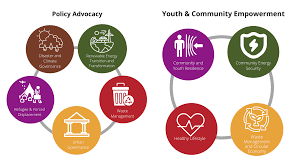The Impact of Programs on Community Development
Programs play a crucial role in fostering community development and bringing about positive change. Whether it’s educational initiatives, healthcare programs, or social welfare projects, well-designed programs have the power to uplift individuals and transform societies.
Educational Programs
Education is often seen as the cornerstone of development. Educational programs provide individuals with knowledge and skills that empower them to reach their full potential. By investing in education, communities can break the cycle of poverty, increase economic opportunities, and foster innovation.
Healthcare Programs
Access to quality healthcare is essential for a thriving community. Healthcare programs aim to improve health outcomes, provide preventive care, and ensure access to medical services for all members of society. By promoting wellness and addressing health disparities, these programs contribute to a healthier and more resilient community.
Social Welfare Programs
Social welfare programs are designed to support vulnerable populations and address social issues such as poverty, homelessness, and unemployment. These programs offer assistance in the form of food aid, housing support, job training, and other essential services that help individuals in need lead more stable and fulfilling lives.
The Role of Nonprofit Organizations
Nonprofit organizations play a vital role in designing and implementing programs that benefit communities. These organizations often collaborate with government agencies, businesses, and volunteers to deliver impactful services that address various social challenges. Through advocacy, fundraising, and community engagement, nonprofits strive to create lasting change.
Measuring Success
Effective program evaluation is key to measuring success and ensuring that resources are used efficiently. By collecting data on program outcomes, monitoring progress, and soliciting feedback from participants, organizations can assess the impact of their initiatives and make informed decisions for future improvements.
In Conclusion
Programs have the potential to drive positive change at the individual, community, and societal levels. By investing in well-planned initiatives across different sectors, we can create stronger communities that are equipped to tackle challenges and embrace opportunities for growth. Together, let’s continue supporting programs that make a difference.
Understanding Community Programs: FAQs on Benefits, Types, Involvement, Success Factors, Funding, and Impact
- What is a program?
- How do programs benefit communities?
- What types of programs are available for community development?
- How can I get involved in programs in my area?
- What are the key components of a successful program?
- How are programs funded?
- What impact do programs have on individuals?
What is a program?
A program, in the context of computing and software development, refers to a set of instructions or code that is designed to perform a specific task or achieve a particular goal on a computer system. It is a sequence of commands that are executed by the computer to carry out predefined operations, such as running applications, processing data, or performing calculations. Programs can range from simple scripts to complex software applications and are essential for controlling the behavior of computers and enabling them to perform various functions efficiently and accurately.
How do programs benefit communities?
Programs benefit communities in numerous ways by addressing specific needs, fostering development, and promoting well-being among residents. Educational programs enhance skills and knowledge, empowering individuals to contribute meaningfully to society. Healthcare programs improve access to quality medical services, leading to healthier populations. Social welfare programs provide essential support to vulnerable members of the community, reducing inequality and promoting social cohesion. By offering resources, opportunities, and support systems, programs play a vital role in enhancing the overall quality of life and creating a more resilient and thriving community for all its members.
What types of programs are available for community development?
Various types of programs are available to support community development initiatives. These programs encompass a wide range of focus areas, including education, healthcare, social welfare, infrastructure development, economic empowerment, and environmental sustainability. Educational programs aim to enhance skills and knowledge within the community, while healthcare programs focus on improving access to quality medical services. Social welfare programs provide support for vulnerable populations, and infrastructure development projects aim to enhance the physical environment. Economic empowerment programs help create job opportunities and financial stability, while environmental sustainability initiatives promote eco-friendly practices. By offering diverse program options, communities can address specific needs and work towards holistic development.
How can I get involved in programs in my area?
To get involved in programs in your area, there are several steps you can take. Start by researching local organizations, community centers, and nonprofits that offer programs aligned with your interests or causes you care about. Reach out to these organizations to inquire about volunteer opportunities, events, or ways to support their initiatives. Attend community meetings, workshops, or networking events to connect with like-minded individuals and learn more about ongoing programs in your area. By actively seeking out information and engaging with local resources, you can find meaningful ways to contribute and make a positive impact through programs available in your community.
What are the key components of a successful program?
When considering the key components of a successful program, several factors come into play. First and foremost, clear and measurable goals are essential to guide the program’s direction and evaluate its impact. Effective communication and collaboration among stakeholders, including participants, staff, and partners, are crucial for ensuring alignment and support. Adequate resources, both financial and human, must be allocated to implement the program efficiently. Flexibility to adapt to changing circumstances and feedback is also important for program sustainability. Finally, regular monitoring and evaluation processes help track progress, identify areas for improvement, and demonstrate the program’s effectiveness in achieving its intended outcomes. By incorporating these key components, a successful program can make a meaningful difference in its target community or audience.
How are programs funded?
Programs are funded through a variety of sources, depending on their nature and purpose. Many programs receive funding from government grants, which are allocated to support specific initiatives in areas such as education, healthcare, and social services. Nonprofit organizations often rely on donations from individuals, corporations, and foundations to finance their programs. Additionally, some programs generate revenue through fees for services or events they offer. Fundraising activities, sponsorships, and partnerships with other organizations are also common strategies used to secure funding for programs. Overall, a diverse funding approach is typically necessary to sustain and expand programs that benefit communities and address important social issues.
What impact do programs have on individuals?
Programs have a profound impact on individuals by providing them with opportunities for growth, development, and empowerment. Through educational programs, individuals gain knowledge and skills that enhance their personal and professional capabilities. Healthcare programs ensure access to essential medical services, promoting well-being and improving quality of life. Social welfare programs offer support to those in need, fostering a sense of security and belonging. Overall, programs play a crucial role in shaping individuals’ lives by equipping them with resources and support to thrive and reach their full potential.




